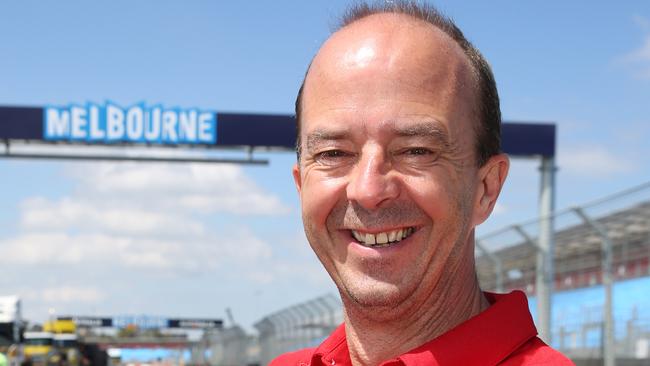Meet Andrew Westacott, the man who has put the Australian Grand Prix back in the fast lane
TICKET sales are up. Government funding is down. And corporate types are flocking back. Meet the man who is reviving the fortunes of our Grand Prix.

Business
Don't miss out on the headlines from Business. Followed categories will be added to My News.
AUSTRALIAN Grand Prix Corporation chief Andrew Westacott is the first to admit his sport is not “entrenched in the Australian psyche” the way AFL, cricket and even the Spring Racing Carnival are.
“We love footy, cricket and horse racing — Formula One was imposed as a sophisticated marketing tool to promote the city,” he told BusinessDaily.
“But people do love motorsport in Australia ... from the time Jack Brabham was racing around the world.”
While he says there is a passion for the sport, he faces challenges that his peers — notably Gillon McLachlan at the AFL and James Sutherland at Cricket Australia — don’t face.
While those codes control much of their own TV rights and advertising deals, the Australian Grand Prix Corporation does not have this revenue stream.
Cash from Formula One broadcast rights goes direct to the international F1 organisation, Formula One Group, run by Bernie Ecclestone.
The main revenue driver for Australian F1 is ticket sales for the four-day event, which culminates for 2015 with the race this Sunday.
To put that into context, Cricket Australia makes more than half of its revenue from TV rights alone while the AFL’s broadcast rights provide about half of the league’s turnover.
And while football and cricket have strong family attendance bases, the F1 suffered during the financial crisis as it has a strong focus on corporate customers.
In 2005, before the financial crisis, it raked in $52 million in revenue. But in 2010, in the shadow of the crisis, that figure had plummeted to just over $31 million. Mr Westacott — who has run the show for four years — believes there is nonetheless plenty of mileage yet in the grand prix’s prestige reputation.
Among his early reforms, the corporation invested heavily to upgrade facilities for fans while better tailoring ticket deals and changing race times to capture a wider audience.
In 2013, revenue was back up to $40 million and last year the tally was $38.3 million. Ticket revenue last year accounted for about $30 million of that while sponsorship deals made up most of the rest.
Last year’s accounts show the State Government put in about $60 million to cover the rest of the costs.
Mr Westacott’s driver for change is simple.
“Melbourne cannot stagnate. If we do, Sydney will jump all over us,” he says.
ONE way the corporation has moved to build the audience has been to embrace Australia’s extensive fan base for V8 Supercars by including a support race during the event.
A plan for that race to earn points towards the V8 season proper hit a snag when there was a delay to a broadcast rights deal that needed to be bedded down first. But Mr Westacott still sees upside for this year. “They (the V8 cars) are racing on the best track in Australia. Our event brings fans closer to the cars,” he says.
Mr Westacott says investments in facilities from 2010 onwards have helped lure the corporate set back to the Grand Prix.
“I think in this environment, innovation and continual refreshment is absolutely critical,” he says.
“The challenge we have is unique. We have it come along once a year ... we can’t afford to get it half right.”
He says one of the trends the Australian Grand Prix Corporation has observed is the growth in demand for quality facilities. “We have to make sure when people are watching at the event that they have all the creature comforts delivered at world-class standards,” he says.
Other changes have included a move to introduce single-day ticketing in 2010 and “value added” packages, with options such as upgrades to grandstand seating and undercover areas, or admission to premium zones.
The move to start the race later in the afternoon has also helped, he says, as it suits families and corporate groups better.
Mr Westacott says another future revenue boost will come by reaching out to the huge — and growing — number of middle-class people in Asia who are motorsport fans.
The corporation is working with Tourism Victoria on ways to promote key destinations, such as the Great Ocean Road and the Yarra Valley, alongside the event to prospective visitors.
Another initiative is making the Grand Prix more of an “experience”.
For instance, in the absence of the Australian International Motor Show — which ceased in 2012 — Mr Westacott has started getting the likes of JAG, Renault and Ferrari to display their hottest vehicles for fans.
Those fans are also potential buyers. Research shows 75 per cent of race fans checked out these displays last year. “And they sold five Porsche Macans,” Mr Westacott says.
Is Melbourne getting good value for money from Formula One? How else could Andrew Westacott improve the Grand Prix? Share your thoughts below.


